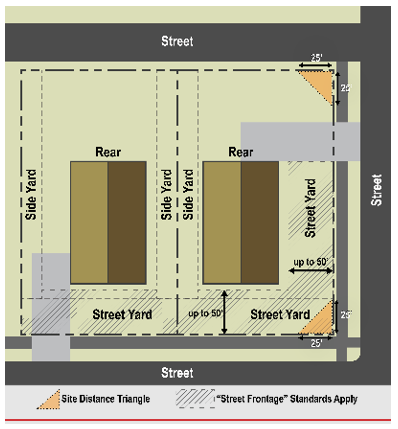9.9.1 Height
A. The maximum height of a fence or wall shall be as shown in the table below, unless:
1. A higher fence or wall is allowed by other provisions of this Ordinance; or
2. The fence is associated with a recreational facility, such as a tennis court; or
3. The fence is associated with an electrical substation; or
4. As otherwise required by another local, State, or Federal government rule or law.
|
Fence or Wall Location |
Maximum Height, in Feet |
|
|---|---|---|
|
Rural |
Other Tiers |
|
|
Street Frontage |
||
|
By Right, Non-Electric |
8 |
4 |
|
Street Frontage – Corner Lot Side Street |
||
|
By Right, frontage along building side starting at front building line |
8 |
6 |
|
With a Minor Special Use Permit: |
||
|
Electric |
10 |
10 |
|
No Street Frontage |
||
|
By Right, Non-Electric |
8 |
8 |
|
By Right, Electric |
10 |
10 |
B. Fences or walls located between the structure and the public or private street, and located up to 50 feet from the street, shall use the “street frontage” standards, except for the following which shall utilize the “no street frontage” standards:
1. Fences or walls located behind the rear building line of a primary structure.
2. Fences or walls that are non-electric and are located along a side yard located beyond the minimum or maximum street yard, as applicable.

C. Posts, columns, or other similar vertical fence or wall supports, including lighting and ornamentation on top of supports, shall be exempt from height requirements. To maintain the exemption, material shall not span from one support to another above the maximum height allowed.
D. Exception to Requirement of a Minor Special Use Permit
When a certificate of appropriateness (COA) is required for a fence or wall, a minor special use permit is not required.
E. Sight distance triangles shall be maintained pursuant to paragraph 12.3.1D, Sight Triangles.